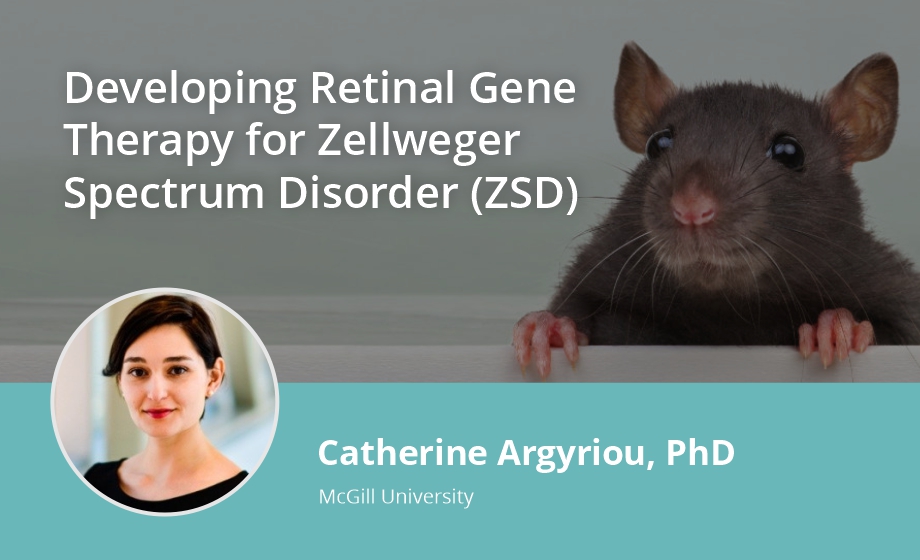Q&A Report: Developing Retinal Gene Therapy for Zellweger Spectrum Disorder (ZSD)
The answers to these questions have been provided by:
Catherine Argyriou, PhD
Postdoctoral Fellow
Human Genetics
McGill University
How did you select the vector design (i.e. serotype, promoter)?
We selected the AAV8 serotype as it most efficiently transduces our primary target cell type (the photoreceptor cells), while still transducing our secondary target (the RPE cells). We chose a ubiquitous promoter as all cells in this model are PEX1-deficient, and we do not fear off-target effects of PEX1 expression. As this was our first proof-of-concept study, we elected to use highly-expressing promoter, and also included an HA tag to facilitate HsPEX1 protein detection in mice with endogenous MmPEX1-G844D. We have since moved to a more clinically-translatable vector design and have achieved more consistent and robust effects than this initial POC.
Why did you choose subretinal versus intravitreal vector delivery? Have you tried intravitreal?
We selected subretinal delivery to best access our target cells – the outer retina, where the retinal phenotype originates in this model. We have not tried intravitreal injection.
Why is 10E10 considered the highest AAV dose possible for the mouse subretinal injections?
The maximum dose is limited by vector concertation and will differ depending on production batch. This was the highest dose we could administer without diluting the vector.
So, you performed injection transsclerally? And did you first create a retinal detachment and injected the vector afterwards, or did you do it in one step?
These injections were trans-scleral. Retinal detachment and vector delivery were performed in one step.
How does the HsPEX1.HA amount and pattern compare to endogenous MmPEX1 in the retina?
The HsPEX1.HA distribution pattern matches that of endogenous MmPEX1, but overexpressed at least 5-fold.
Where is Pex1 normally expressed in the mouse retina (e.g. what cell types)?
PEX1 is concentrated at the inner segment and outer plexiform layer in both mouse and human retina.
What are the RPE defects in PEX1 mutant mice and when do they start? Did the gene therapy help this?
We have characterized the RPE defects in the mouse but cannot yet disclose the phenotype. In our more recent expanded study, gene therapy did correct the phenotype.
In LC-MS, did you look at the levels of DHA in these PEX1 mutant retinas? Was this recovered?
Total plasmalogens are not reduced in the PEX1-G844D mouse model, but DHA specifically can be mildly but significantly reduced. DHA levels do not recover with gene therapy.
Are there larger animal models of Pex1 mutations, and do you plan to treat any with your gene therapy?
There is no larger animal model of Pex1 disease.
Does supplementation of the Pex1 mutant mice with e.g. long chain fatty acids or other peroxisomal enzyme products improve the retinal phenotype?
Very long chain fatty acids are elevated in peroxisome disorders, and gene therapy corrects this. We have not tried supplementing this model with DHA, which is reduced. However, peroxisome biogenesis disorders result in multiple enzyme deficiencies and perturbations in many metabolic pathways. It is unknown if correcting one metabolite would improve the course of disease. Deeper phenotyping to study this pathophysiology is warranted.
What about side effects (endophthalmitis, cataract, etc.)? How long did it take for the retina to re-attach after injection?
There were no detectable structural or functional side effects post injection. The retina had re-attached when it was visualized histologically 2 months post injection.
Is the mutant mouse considered a model for cone-rod dystrophy since there is an initial cone defect? Do you plan to try cone-targeted gene therapy at early stages?
The progression of retinal degeneration in this model supports it being a cone-rod dystrophy. We do not plan to target the cones exclusively as multiple cell types are affected quickly. However, it would indeed be interesting to test whether exclusive cone-rescue is sufficient to delay or prevent deterioration of other cell types.
Regarding the OptoDrum - how many measurements would preform per mouse/day for visual acuity and contrast thresholds?
Mice were tested once daily (i.e. one test type per day to determine threshold) in the morning hours. This prevented prolonged testing time and reduce the chance of testing fatigue in the mouse.
Would you aim to treat ZSD children or adults in your clinical trials?
Both. We expect the eligibility criteria to be presence of photoreceptor cells. The rate of cell deterioration can vary depending on disease severity.
Given the limited data on the natural history of PEX assoc retinopathy - do you plan deep phenotpying studies? For how long?
Yes. We have recently completed a retrospective analysis of vision in a large ZSD cohort as part of a natural history study. We will soon commence a funded prospective study assessing retinal pathology and functional vision in participants of various ages at 2-3 sites across North America. This will identify the optimal treatment window and clinical outcomes for this population. Assessments will be performed yearly for 5 years, but we expect informative results even after the first tests.
The subretinal injection causes a retinal tear (retina separated from RPE). One would expect this to be more inflammatory?
In clinical practice, more inflammation is detection post intravitreal AAV administration compared to subretinal. Inflammation is treatable and typically resolves.
Do you observe any structural protection of photoreceptors and bipolar cells in addition to the functional improvements in the gene therapy-treated mutant mice?
We have seen striking improvements in retinal structure in our more recent studies, but cannot disclose details at this time.
